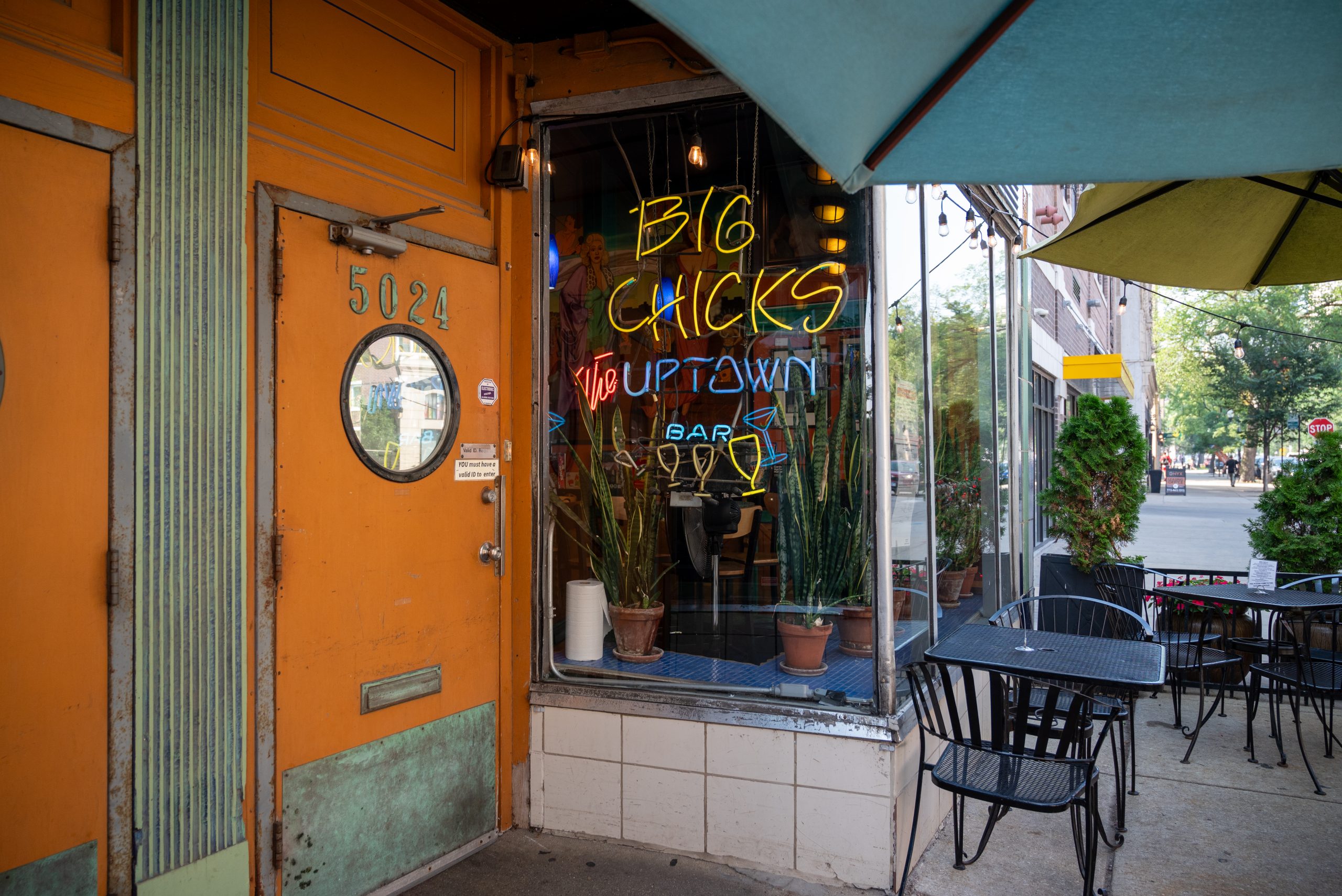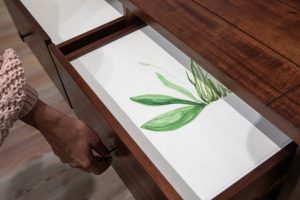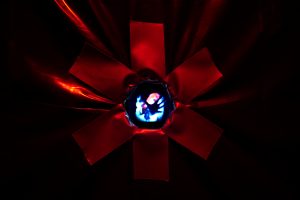An oak rail and antiqued trim skirt the amberglow-orange walls to the left of the entry, slouching with red party lights. With outflowing angles, light from varied times of day glints the framed photographs. The row of artworks above the high-top tables concern themselves with portraits that are not traditional portraits—but, rather, ambiguous bodies sliced with scattering identifying features. A quad-portrait depicts Black women’s hairstyles from behind; a woman cups her face as she looks away from the camera; a partially nude figure reclines on her side; a ghostly figure turns her head slightly, as if a person was moving in an exposing (photographic sense) way. The framed glass seals, reflects, and refracts neon light writing and fixtures from across the bar. Big Chicks, a Chicago uptown LGBTQ+ bar, comfortingly silhouettes all figures—artwork or not.
Time and space is bent at the bar (and the adjoining restaurant Tweet) to different effects, depending on season and time of day. The entrance is thickly cocooned during the winter—a step inside is a hug into a magician’s cape. Peeling back the curtains protecting from the cold, the door person greets you as you arrive, checking an ID. Spring and Summer, the entrance is airy and muted by soft light. No matter the temperature, it manages to still nestle in the sweet spot between cozy and demure. It has a vibe that feels outside of time.
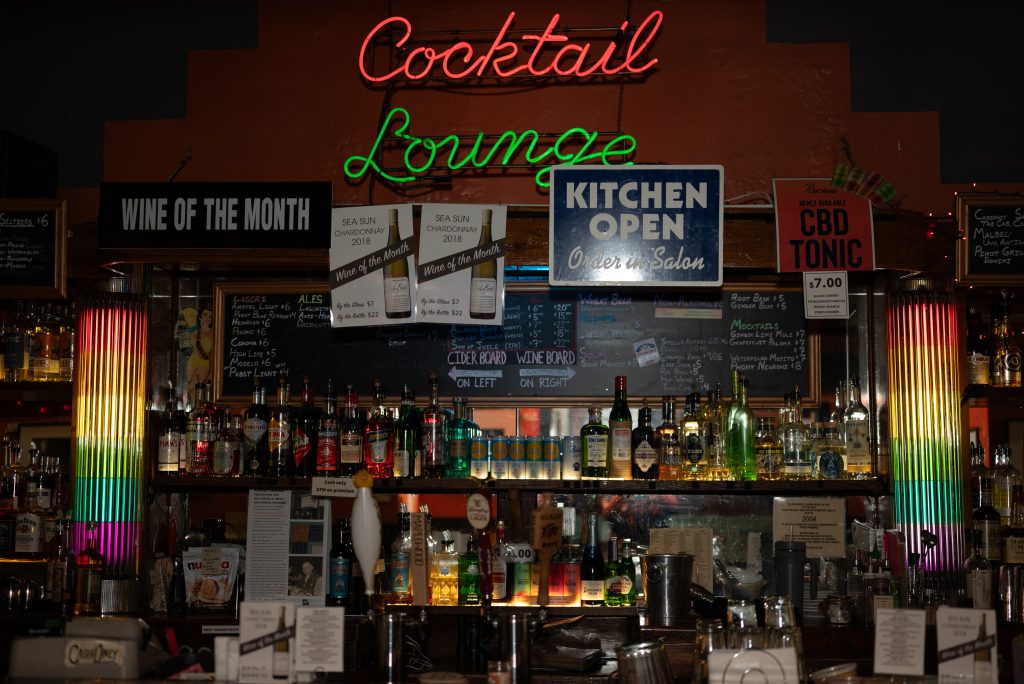
The decor of the building has changed over the years as the vision for Big Chicks evolved. It was a dive when owner Michelle Fire purchased it in 1986, with a clientele eclectic to the neighborhood’s working class ethos and historical buildings. In fact, the year prior to her purchase, civic leaders were pushing to protect the original architecture of the area, some of which dates to the early 1900s. Fire fought to preserve that civic pulse as well—interior and exterior. She remembers lovingly exclaiming “what’re you doing!” as the first customers stepped on the work-in-progress of the new flooring, which was replacing the original carpet for laminate orange and light blue tiles (and their Chihuahuas lounged on the bar). During construction of the bar, she also had the beginnings of her collection on display, with a circus scene tacked to the walls.
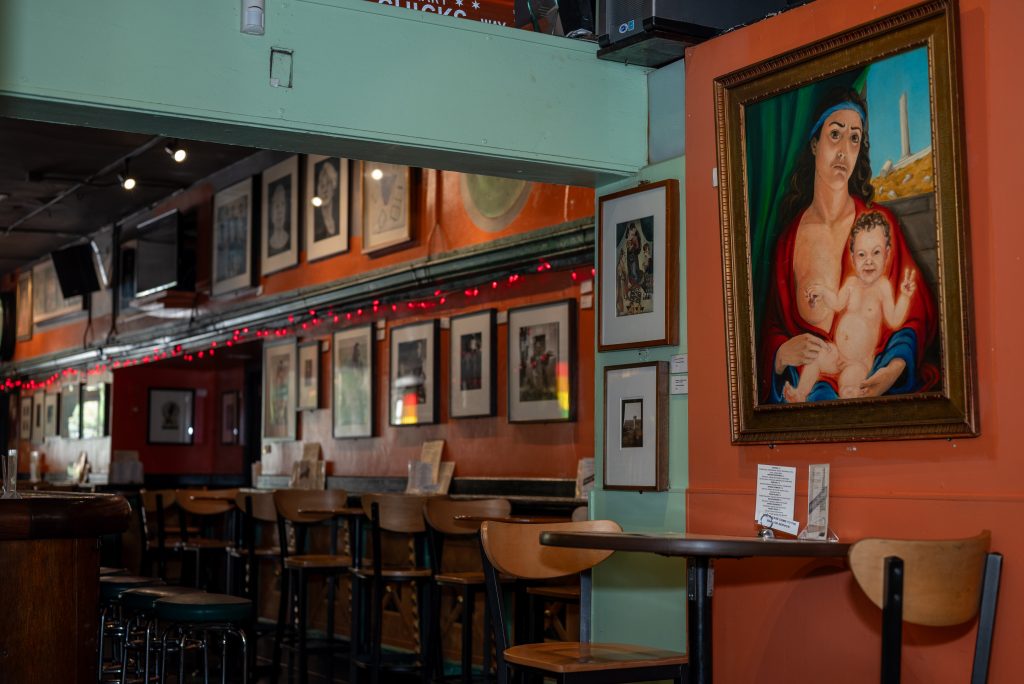
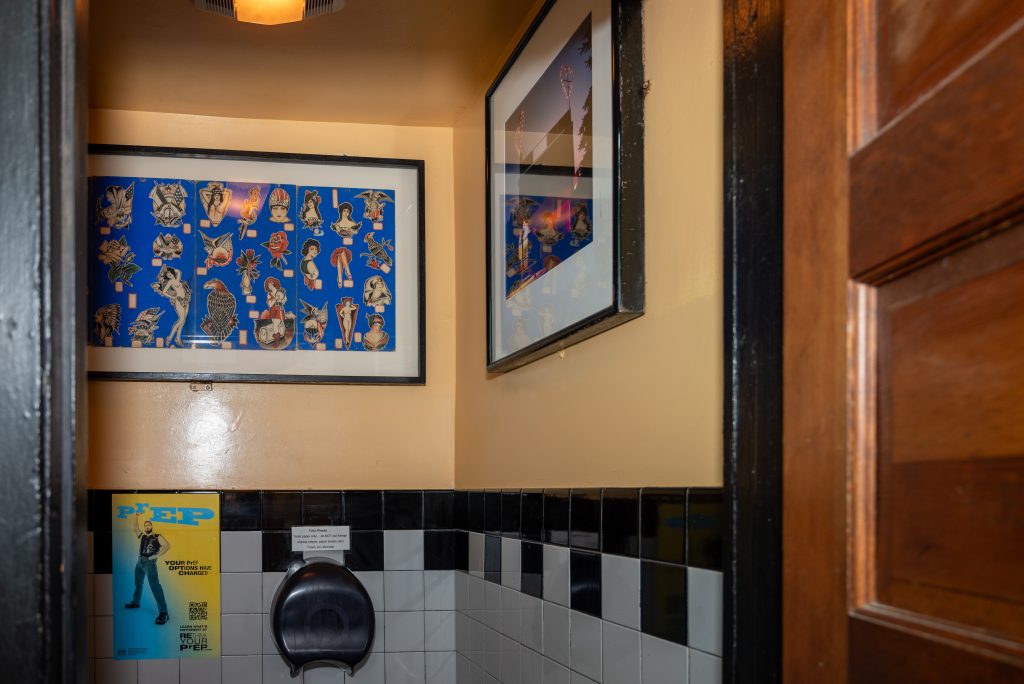
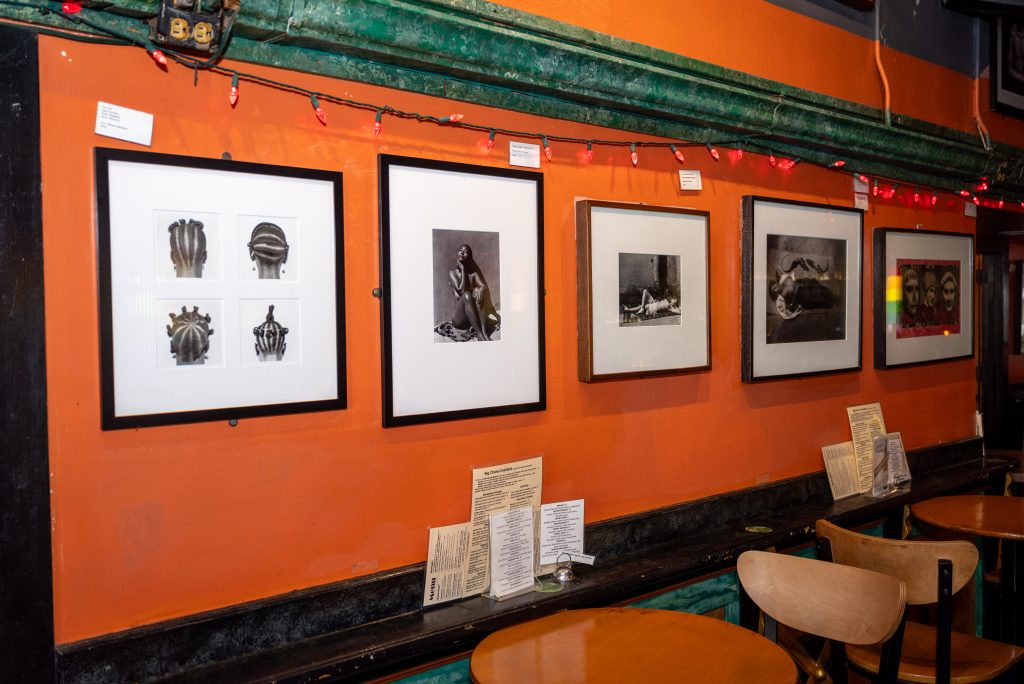
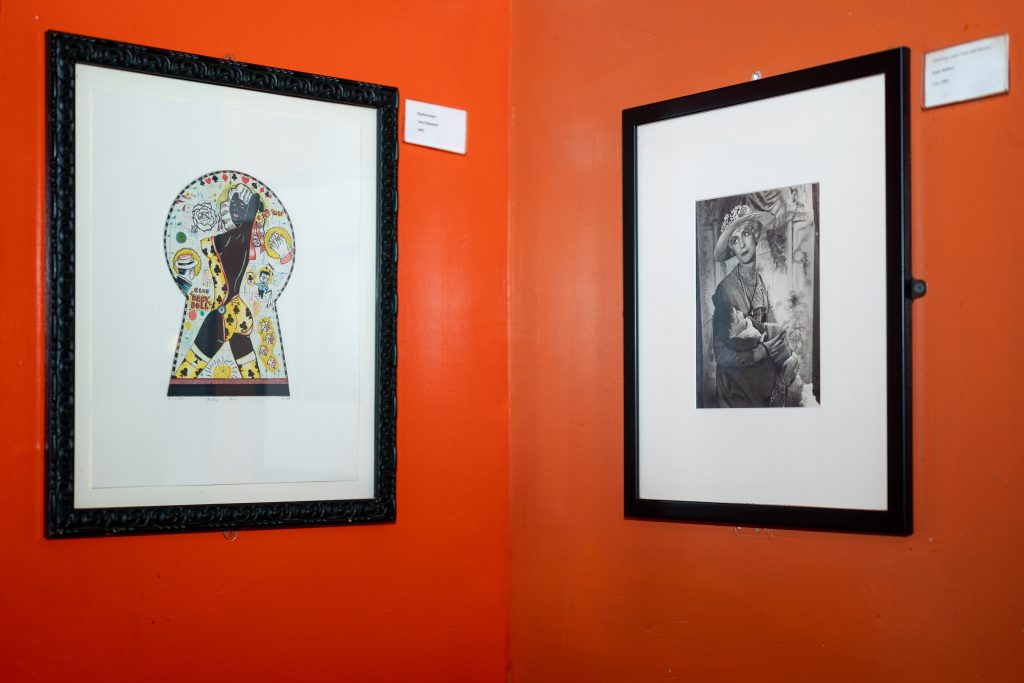
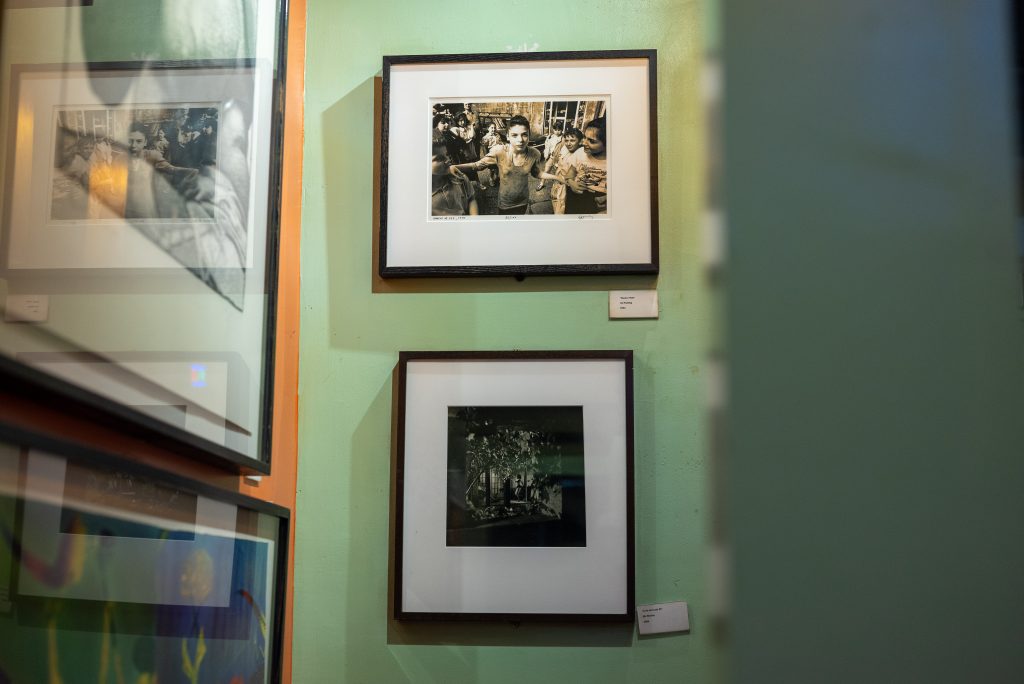
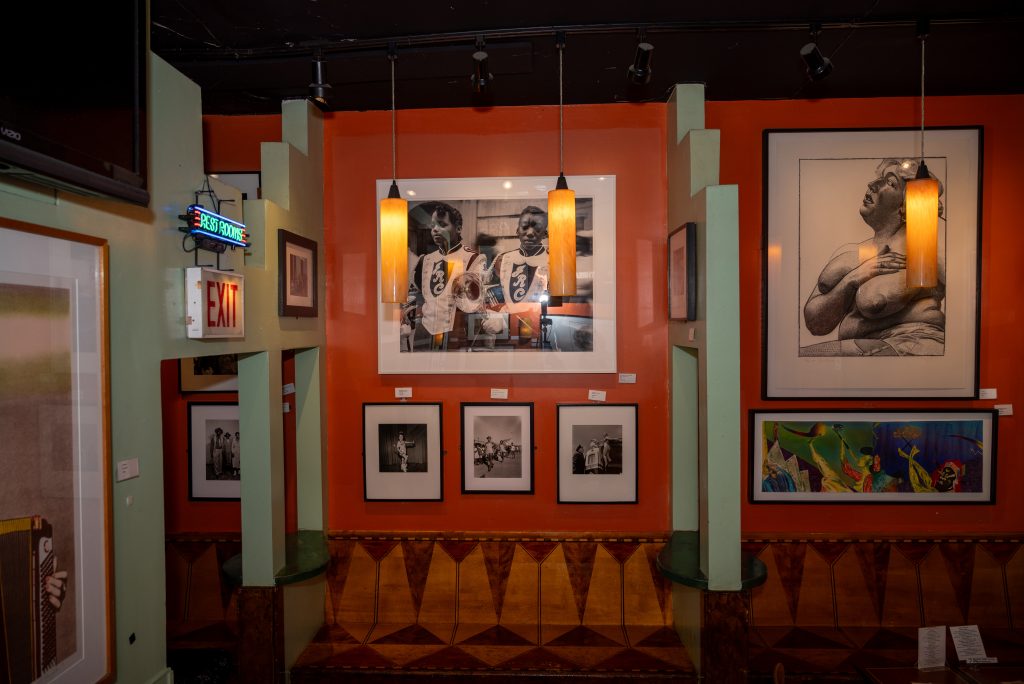
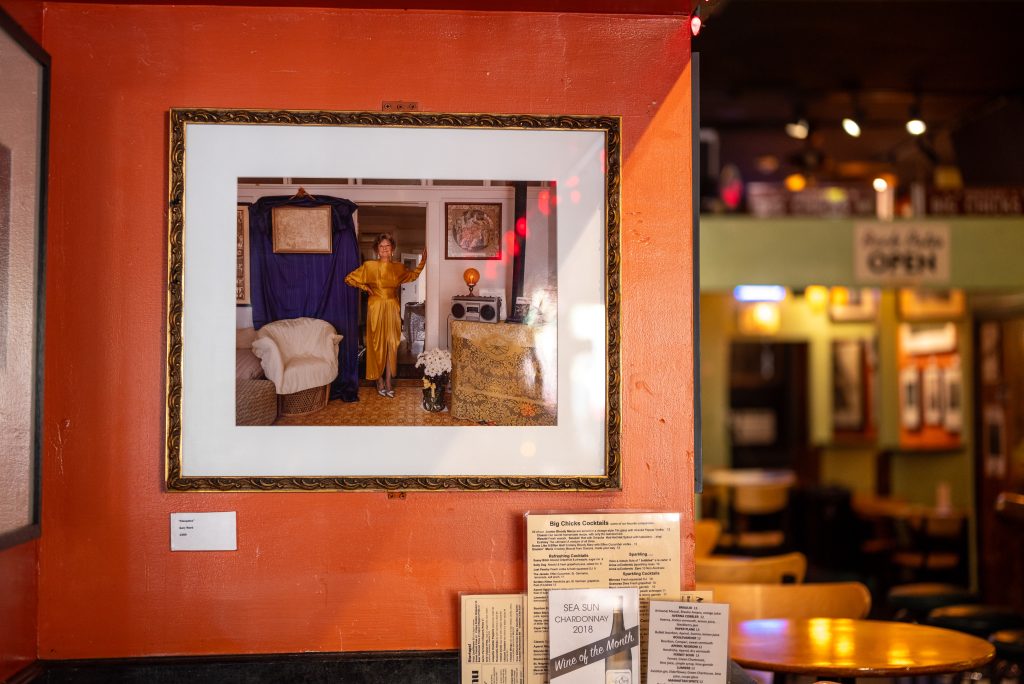
The staff’s greetings reverberate the artwork too: lovingly punchy, slyly flirtatious. Their pleasantries aren’t just surface charm—they insist that it’s your neighborhood bar, even if you’re not from the neighborhood.
It was an “active” and “fabulous” time, according to Fire, when she first generated the collection. Often bought under “layaway” (successive payments over a series of months), Fire sleuthed the late 70s and 80s Chicago art scene as a supporter and participant, often trading with fellow artists. In quick stops during her weekday brunch shift, Fire named galleries, curators, and artists she worked with in creating Big Chicks collection over the years. As a former Guggenheim curator, she fostered a relationship with Anita David, gained influence from Jim Faulkner, and the not-for-profit Untitled Gallery’s support among others.
In a wider context of the city, the time was, in fact, prolific: The Museum of Contemporary Art (MCA) opened in 1967. They exhibited artists ranging from Laszlo Moholy-Nagy to Franz Kline to Sol Lewitt to ring in the 1970s, although conversations soon ensued about representation of local artists versus national/international. Institutions reckoned on how to bridge the divide. Lynne Warren, curator from 1982-2020 at the MCA, wrote the way to exhibit in the city was “not by courting a curator, but by organizing the exhibition oneself” in alternative spaces. A 1972 exhibition at the Hyde Park Art Center reflected on similar institutional divisions in Chicago art—the committee selecting 67 local artists. Art critic Jane Allen decried “it’s a sad fact that art like almost anything else in Chicago is riddled with politics.” However, not unlike Fire’s ethos of art collecting, the community made efforts in showing the underbelly of Chicago art.
With this context formulating her art experience, Fire opened Big Chicks in 1986. It was a time marked by more recognition of cooperative feminist spaces like ARC and Artemisia (their tenth anniversary was two years prior). Fire specifically noted N.A.M.E gallery as a space she frequented: founded in 1974 by School of the Art Institute of Chicago students, it was colloquially christened “Now All May Exhibit.” The space was “alternative” and focused on artists who were not a part of the Chicago Imagist movement that was soaking the attention of Chicago collectors and patrons. It was an effort of skill and opportunity sharing not for a general public but fellow artists. Guy Whitney, a founder of N.A.M.E, wrote it was necessary for them to provide an “energy hub [that] existed for our community.” This philosophy continued for years, at least until Chicago Tribune’s Alan G. Artner gave a conflicting account on how a regime change in May 1984 provided a Ray Oshida (popular Imagist) exhibition.
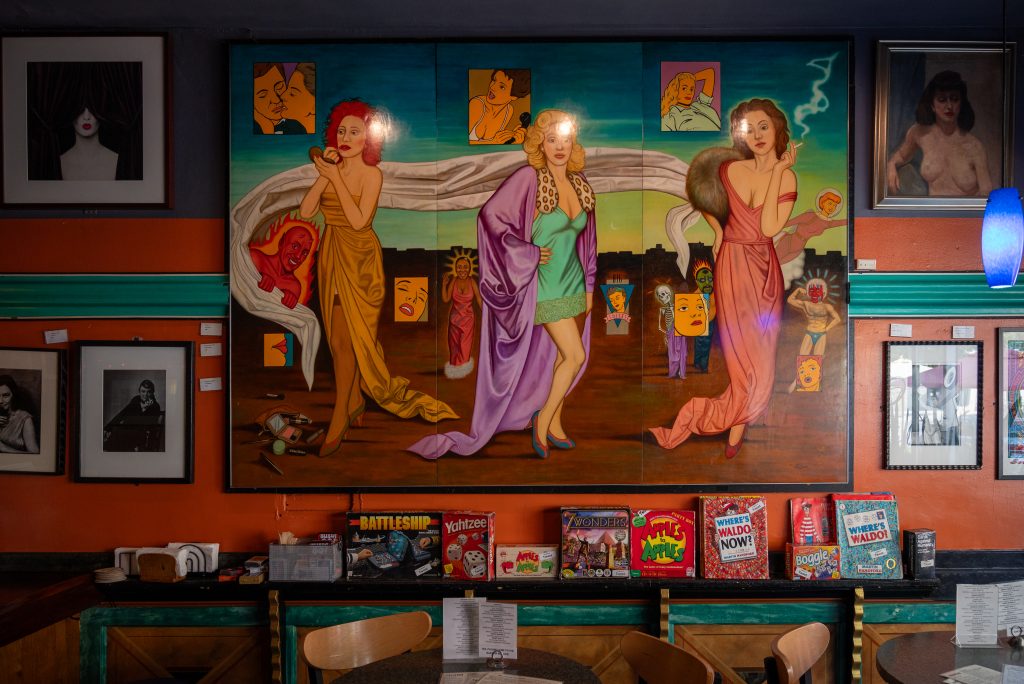
Amidst this influx of art styles, political movements, gender politics and alternative spaces, Fire focused on the Queer community. Mirrored with the art was the death of disco in 1979, and underground club scenes like the Warehouse saw the burst of House music and other underground LGBTQ+ nightlife scenes. Enmeshed in a confluence of those styles, she pierced and pieced an archive of her contemporaries that worked in between the mainstream art market and one of private art collectors, enthusiasts and patrons. This formed the basis of Big Chick’s place within Chicago’s Queer and arts subculture ecosystem, which continues to this day.
The back section, far more hospitable to friendly gatherings with low and high tables, hosts Mark Jackson’s “Reclining Nude” (1989). The photograph drapes a rocky necklace over a woman’s body. Greyed contoured lines map its yellowed paper—an afterglow. According to John Neff’s former gallery “Iceberg Projects”’s 2012 curation of Jackson, the artist is “an inveterate collector of outsider and self-taught art,” and a longtime Midwestern photographer and 2-dimensional artist. Big Chick’s artwork streams his scrapbook of the coyly ephemeral.
Adjoined is photographer Micky Pallas’s “Female Impersonator Grand Entrance” (1955), a drag queen in a mermaid gown walks into a flurry of organza. Frozen in black and white, is the camp-y grin and almost-closed eyes are a glee performance .
On my most recent visit a week ago, I sat at the curved corner on a leather-cushioned stool. Art deco style lamp-pillars contour the actual bar, the elixir fluting the interior. Its projections cast inwardly (self-protection). Salon-style artwork dances in the periphery. I furtively gazed and scribed on that happy hour visit–scrawling down the label information of Sa Schloff’s “the Bearded Lady” (1982) photograph among others. The figure (unbeknownst officially to me) shows a glimmer of what Chicago’s Queer nightlife was like in the late 1970s and 1980s. The Bearded Lady, a performer at Dugan’s Bistro in Chicago (Chicago’s own Studio 54 Disco club) was a social chameleon. “He was a pioneering radical faerie working as go-go boy in a gay urban jungle,” wrote Owen Keehnen. He was a mysterious, but omnipotent presence.
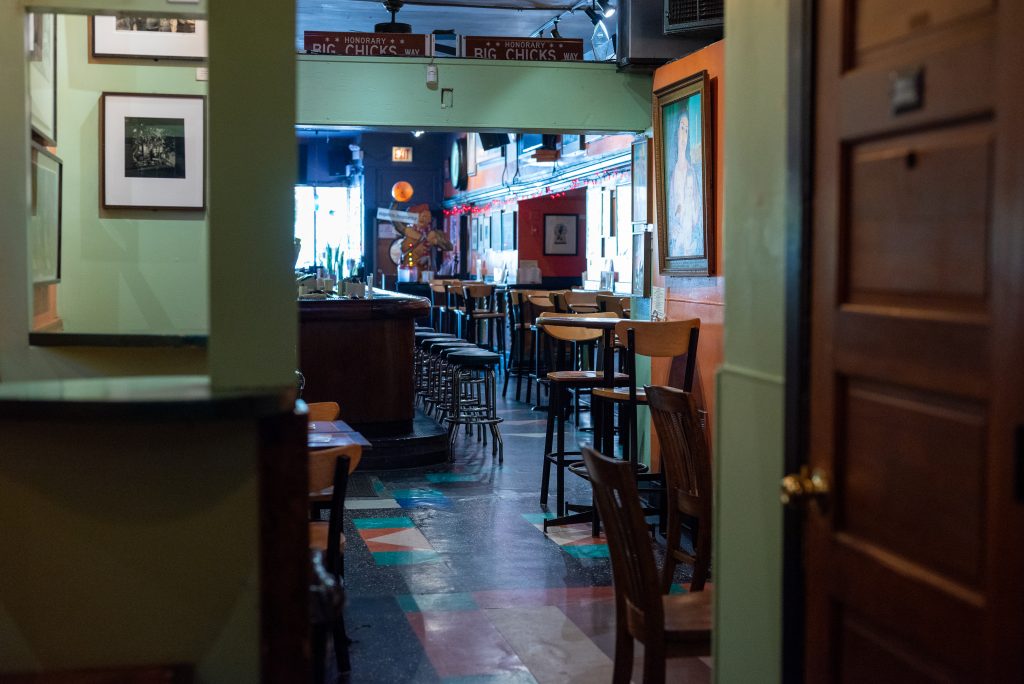
There’s a comfort in peripheral figures of Queer spaces of the night like the Bearded Lady; Big Chicks, however abstract, monumentalizes this.
Fire described the Big Chick’s as the “nude side” compared to the Tweet artwork, but that’s a disguise. It’s key to remember nudity isn’t just nakedness in this case—it’s vulnerability and bodily autonomy. You can remain anonymous, but safe in a space like Big Chicks. Maybe you’ll never utter your name, but mood-lighting will slightly reflect on your teeth as you smile. Maybe there’s a brief kiss with a one-time lover on a date, where the sexual tension remains in the rivets of the stools. And that’s the key: nudity, but anonymity. That’s comfort, that’s freedom.
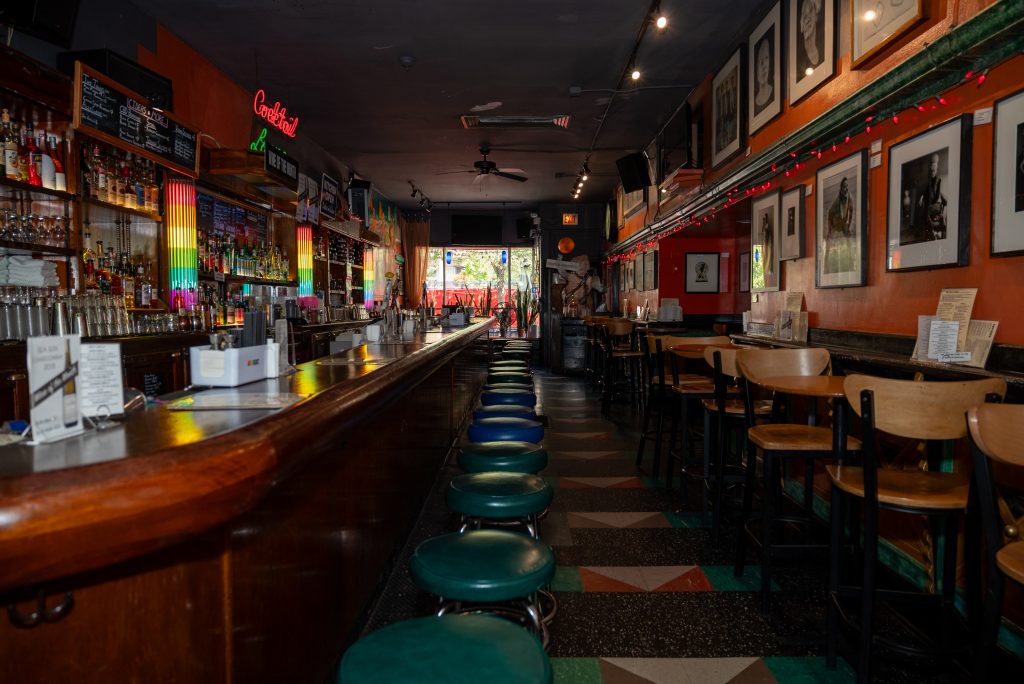
Big Chick’s art collection inhabits space just as queer people do—sometimes hidden, sometimes flamboyant, but always in an in-between space where all bodies exist at once in LGBTQ+ history. Specific people are pinpointed in the bar of course—the ones you arrived with, sometimes the familiar faces within, the specific artist or muse. But others remain ambiguous and ambivalent, cocooned to the bar’s architecture. Side-glances and sly winks occasionally reveal these keen artist-observers as well.
Big Chick’s fringe figures are (touchingly) just suggestions. But then there’s that one personage that jumps—whom you tell your name to, and you like the way their lips move when enunciating the syllables for the first time. Maybe the Bearded Lady is that person.
Big Chicks is the spectacular of the private; when queerness can slumber relaxed as itself whether it’s in secrets shared under breath right at bar-time, or brightly at 4 pm near the ceremonial, convivial artwork.
“I’ve seen you around before, right?” said the bartender as I cashed one more High Life. “Yeah, at night, in the morning, in the evening. I’m around,” I said.
Big Chicks is located at 5024 N Sheridan Rd Chicago, IL 60640. Stay up to date here as they seek Landmark status.
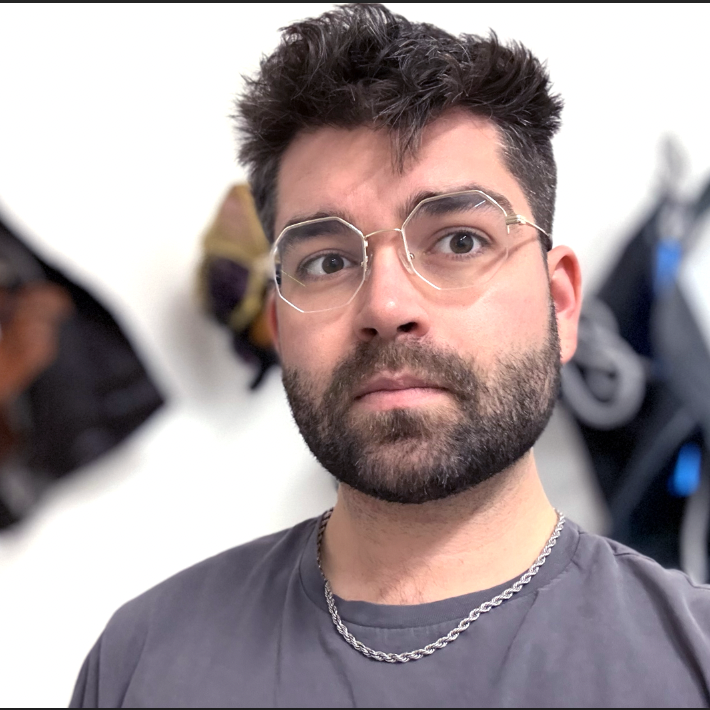
About the author: Samuel Schwindt is always looking for the maddest spectacles and vampiest explosions. A word|object|surface-smith, he originates from an evangelical community and contradictory motorcycle culture in Indiana (he left religion on highway 65 north to Chicago). Through his young-life he honed skills in wood and metal, and used his craft-history to receive a BFA in Studio Art from the School of the Art Institute of Chicago and an MFA in Interdisciplinary Art from University of Illinois at Chicago. Now, he works as commission-based leather-gear crafter, archivist, sculptor, curator, freelance writer, and educator.
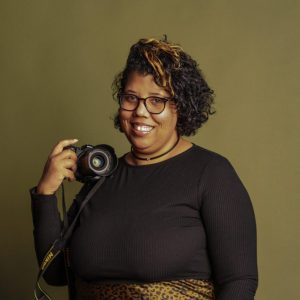
About the photographer: Tonal (tuh-nawl) (they/them), is a bi-racial Black non-binary Photographer from the Midwestern city of Kalamazoo, MI, where tall grass and even taller trees first nurtured their creative spirit. Currently based in the vibrant city of Chicago, IL, Tonal’s artistic journey is a testament to the power of self-discovery and passionate exploration through community. Inspired by the authenticity of Chicago’s Black Queer art scene, their artistry is a symphony of colors, emotions, and storytelling, as they skillfully weave vibrant and authentic narratives of Black and Brown 2SLGBTQIA+ communities. Their portrait work invites viewers to pause and witness the fullness of Black and Brown queer personhood in bloom.
